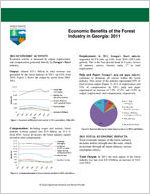Economic Benefits of the Forest Industry in Georgia: 2011
2011 ECONOMIC ACTIVITY Economic activity is measured by output, employment, and compensation generated directly by Georgia's forest industry.
Output: Almost $15.1 billion in total revenue was generated by the forest industry in 2011, up 4.0% from 2010. Figure 1 shows the output by sector from 20042011.
Employment: In 2011, Georgia's forest industry supported 46,378 jobs, up 6.8% from 2010 (2953 jobs gained). This is the first upward trend in 4 years. Across all industry sectors, forestry ranks 3rd in total employment
Pulp and Paper: Georgia's pulp and paper industry continues to dominate all sectors within the forest industry. This sector of the industry represented 69% of total revenue output (Figure 3), 41% of employment, and 55% of compensation. In 2011, pulp and paper experienced an increase of 7.9%, 12.2%, and 15.9% in output, employment, and compensation, respectively.
Compensation: Including wages and salaries, forest industry workers earned over $2.9 billion, up 13.3 % from 2010. Across all sectors, the forest industry ranked second in total compensation.
2011 TOTAL ECONOMIC IMPACTS Total economic impact of the forest industry includes dollars brought into the state, which recirculate through all major industry sectors (multiplier effect).
Total Output: In 2011, the total impact of the forest industry was just over $25.0 billion, an increase of 5.6% over 2010.
An Equal Opportunity Employer and Service Provider
Total Employment: The forest industry supported 118,459 jobs in 2011 (10,347 jobs gained). Total employment supported by the forest industry grew 9.6%.
Total Compensation: In 2011, the forest industry supported $6.5 billion in wages and salaries, up 20.7% from 2010.
From 2008 to 2010, total output supported by the forest industry was in a decline, trailing behind total employment and compensation which has been declining since 2006. 2011 economic data show increases in total output, employment, and compensation for the forest industry; a trend that is hoped to continue with an improving economy.
ECONOMIC IMPACT BY REGION Local economies are impacted by the forest industry by supporting employment, bringing in additional dollars, and recirculating the dollars across local businesses. In regions where forestry is a large proportion of the local basic industry, all economic support is generally dependent. Figure 5 shows Georgia's 12 regional commissions.
Fiscal Revenue Impacts In 2011, the forest industry generated $487.2 million in revenues for the state budget. Net annual revenues (total revenues minus costs) totaled $179.3 million for an increase of $13.5 million from 2010.
Figure 5. Georgia's 12 Regional Commissions
Employment by Region The Atlanta Regional Commission, Heart of Georgia Altamaha, and Northwest Georgia are the top three commissions in terms of employment, accounting for 40% of the forest related jobs in Georgia. However, Southern Georgia, Heart of Georgia Altamaha, and Southwest Georgia have the three highest employment percentages compared to total employment at 3.0%, 5.2%, and 2.7%, respectively.
Compensation by Region The three regions with the greatest dependency on forest based compensation compared to total compensation are Heart of Georgia Altamaha, Southern Georgia, and Southwest Georgia with 10.8%, 6.3%, and 5.1%, respectively. Atlanta Regional Commission provided the most compensation at $631.6 million; however, forestry accounted for only 0.6% of their total compensation.
Reference Economic Benefits of the Forestry Industry in Georgia, 2011. Enterprise Innovation Institute. Georgia Institute of Technology, 2012.
An Equal Opportunity Employer and Service Provider
